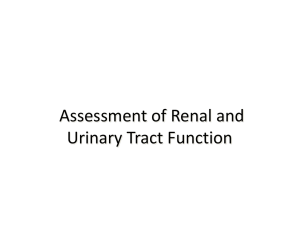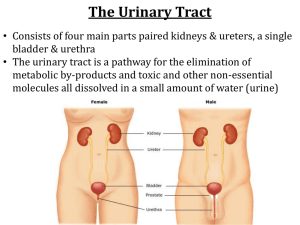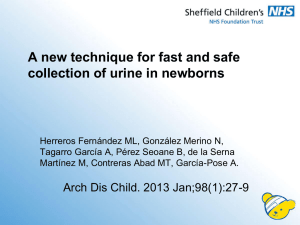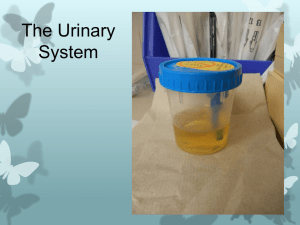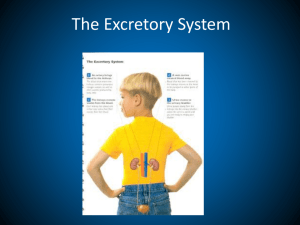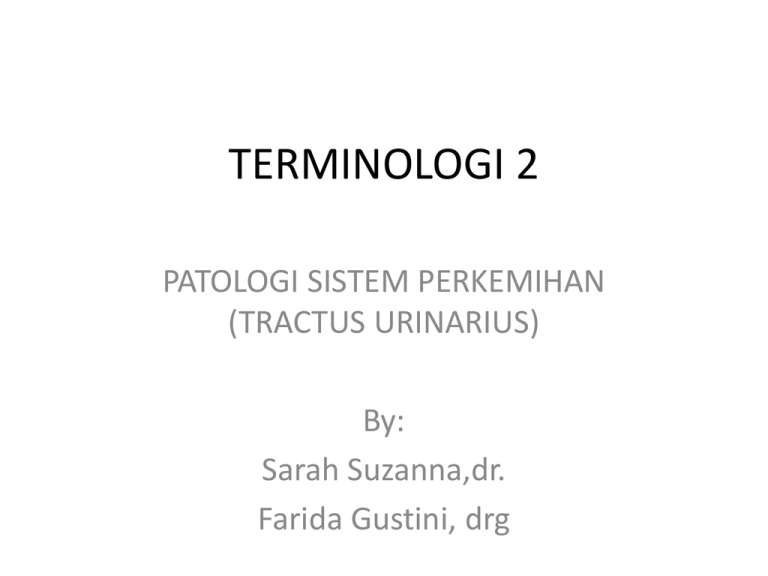
TERMINOLOGI 2
PATOLOGI SISTEM PERKEMIHAN
(TRACTUS URINARIUS)
By:
Sarah Suzanna,dr.
Farida Gustini, drg
Sistem perkemihan
• Sistem yang menghasilkan urin untuk mengeluarkan produk2
sisa dari tubuh
• Terdiri atas sepasang Ginjal, sepasang Ureter, sebuah Kandung
kemih, dan sebuah Urethra
Anatomi dan Fisiologi
1.
Ginjal
- Pada orang dewasa ginjal panjangnya 12-13 cm, lebarnya 6 cm dan
beratnya antara 120-150 gram. Ukurannya tidak berbeda menurut
bentuk dan ukuran tubuh
- Permukaan anterior dan posterior katup atas dan bawah serta pinggir
lateral ginjal berbentuk konveks sedangkan pinggir medialnya berbentuk
konkaf karena adanya hilus
- Ada beberapa struktur yang masuk atau keluar dari ginjal melalui hilus
antara lain arteri dan vena renalis, saraf dan pembuluh getah bening
- Struktur fungsional ginjal : Nefron
Anatomi dan Fisiologi
2. Ureter
- Ureter adalah tabung/saluran yang
menghubungkan ginjal dengan kandung
kemih. Ureter merupakan lanjutan
pelvis renis, menuju distal & bermuara
pada vesica urinaria. Panjangnya 25 –
30 cm
Persarafan ureter oleh plexus
hypogastricus inferior T11- L2 melalui
neuron² simpatis.
Terdiri dari dua bagian :
– pars abdominalis
– pars pelvina
Tiga tempat penyempitan pada ureter :
– uretero- pelvic junction
– tempat penyilangan ureter dengan
vassa iliaca sama dengan flexura
marginalis
– muara ureter ke dalam vesica urinaria
Anatomi dan Fisiologi
3. Vesica Urinaria
•
•
•
•
Disebut juga bladder/ kandung kemih. Vesica urinaria
merupakan kantung berongga yang dapat diregangkan
dasn volumenya dapat disesuaikan dengan mengubah
status kontraktil otot polos di dindingnya.
Secara berkala urin dikosongkan dari kandung kemih ke
luar tubuh melalui ureter.
Organ ini mempunyai fungsi sebagai reservoir urine
(200 - 400 cc). Dindingnya mempunyai lapisan otot
yang kuat.
Vesica urinaria mempunyai bagian:
• Apex: Dihubungkan ke cranial oleh urachus (sisa
kantong allantois ) sampai ke umbilicus membentuk
ligamentum vesico umbilicale mediale.
• Corpus
• Fundus
Vesica urinaria dipersarafi oleh saraf otonom
4. Urethra
Merupakan saluran keluar dari urin yang diekskresikan
oleh tubuh melalui ginjal, ureter, vesica urinaria.
Anatomi dan Fisiologi
• Unit fungsional ginjal adalah nefron, yang pada manusia setiap ginjal
mengandung 1-1,5 juta nefron
• Setiap nefron mempunyai dua komponen utama:
1) Glomerulus ( kapiler glomerulus ) yang dilalui sejumlah besar cairan
yang difiltrasi dari darah.
2) Tubulus yang panjang dimana cairan hasil filtrasi di ubah menjadi urin
dalam perjalanannya menuju pelvis ginjal.
• Kecepatan eksresi berbagal zat dalam urin menunjukkan jumlah ketiga
proses ginjal yaitu : Filtrasi glomerulus, reabsorpsi zat dari tubulus renal
kedalam darah dan sekresi zat dari darah ke tubulus renal. Pembentukan
urin dimulai dengan filtrasi sjumlah besar cairan yang bebas protein dari
kapiler glomerulus ke kapsula Bowmen.
• Fungsi primer ginjal adalah rnempertahankan volume dan komposisi
cairan ekstra sel dalam batas-batas normal
• Fungsi lain dari ginjal yaitu memproduksi renin yang berperan dalam
pengaturan tekanan darah.
Key terms for Normal structure and function
Antidiuretic
hormone (ADH)
A hormone released from the pituitary gland that causes reabsorption
of water in the kidneys, thus concentrating the urine
angiotensin
A substance that increases blood pressure; activated in the blood
by renin, an enzyme produced by the kidneys
calyx
A cuplike cavity in the pelvis of the kidney; also calix (plural,
calyces) (root cali, calic)
erythropoietin
(EPO)
A hormone produced by the kidneys that stimulates red blood
cell production in the bone marrow
glomerular
capsule
The cup-shaped structure at the beginning of the nephron that
surrounds the glomerulus and receives material filtered out of
the blood
glomerular filtrate
The fluid and dissolved materials that filter out of the blood and
enter the nephron at the Bowman capsule
glomerulus
The cluster of capillaries within the glomerular capsule (plural,
glomeruli) (root glomerul/o)
kidney
An organ of excretion (root ren/o, nephr/o); the two kidneys filter
the blood and form urine, which contains the waste products of
metabolism and other substances as needed to regulate the water
and electrolyte balance and the pH of body fluids
micturition
The voiding of urine; urination
Key terms for Normal structure and function
nephron
A microscopic functional unit of the kidney; working with blood
vessels, the nephron filters the blood and balances the composition
of urine
renal cortex
The outer portion of the kidney
renal medulla
The inner portion of the kidney; contains portions of the
nephrons and tubules that transport urine toward the renal
pelvis
renal pelvis
The expanded upper end of the ureter that receives urine from
the kidney (root pyel/o, from the Greek word for pelvis, meaning
“basin”)
renal pyramid
A triangular structure in the medulla of the kidney composed of
the loops and collecting tubules of the nephrons
renin
An enzyme produced by the kidneys that activates angiotensin in
the blood
tubular
reabsorption
The return of substances from the glomerular filtrate to the blood
through the peritubular capillaries
urea
The main nitrogenous (nitrogen-containing) waste product in the
urine
ureter
The tube that carries urine from the kidney to the bladder (root
ureter/o)
urethra
The tube that carries urine from the bladder to the outside of the
body (root urethr/o)
urinary bladder
The organ that stores and eliminates urine excreted by the
kidneys (root cyst/o, vesic/o)
urination
The voiding of urine; micturition
urine
The fluid excreted by the kidneys. It consists of water,
electrolytes,
urea, other metabolic wastes, and pigment. A variety
of other substances may appear in urine in cases of disease
(root ur/o).
Roots yg berhub.dgn Ginjal
Roots for the Kidney
ROOT
MEANING
EXAMPLE
DEFINITION OF EXAMPLE
ren/o
kidney
infrarenal
below the kidney
nephr/o
kidney
nephrosis
any noninflammatory disease
condition of the
kidney
glomerul/o
glomerulus
juxtaglomerul
ar
near the glomerulus
pyel/o
renal pelvis
pyeloplasty
plastic repair of the renal pelvis
cali-, calic
calyx
calicectasis
dilatation of a renal calyx
Roots yg berhub. dgn St. perkemihan
Roots for the Urinary Tract (Except the Kidney)
ROOT
MEANING
EXAMPLE
DEFINITION OF EXAMPLE
ur/o
urine,
urinary tract
urosepsis
generalized infection that
originates in the urinary
tract
urin/o
urine
urination
discharge of urine
ureter/o
ureter
ureterostenosis
narrowing of the ureter
cyst/o
urinary bladder
cystotomy
incision of the bladder
vesic/o
urinary bladder
intravesical
within the urinary
bladder
urethr/o
urethra
urethroscopy
endoscopic examination
of the urethra
Pathology of the Urinary System
Patologi St. Perkemihan
1.
•
•
Glomerulonefritis
peradangan pada ginjal yang dimulai dari glomerulus, ditandai dengan
proteinuria dan hematuria. Dapat berkembang jd Gagal ginjal.
Glomerulonefritis akut (GNA) adalah suatu reaksi imunologis pada ginjal
terhadap bakteri atau virus tertentu.Yang sering terjadi ialah akibat
infeksi kuman streptococcus , ditandai dengan timbulnya hematuria,
edema, hipertensi, dan penurunan fungsi ginjal
Pengobatan : istirahat, diet, pembatasan cairan dan garam, antibiotik,
anti hipertensi, antidiuretik bila perlu
Glomerulonefritis kronis adl kerusakan ginjal yang terjadi selama 3
bulan atau lebih, berdasarkan kelainan patologik atau petanda kerusakan
ginjal seperti kelainan pada urinalisis, dengan penurunan laju filtrasi
glomerulus ataupun tidak. Ditandai dengan penurunan semua faal ginjal
secara bertahap, diikuti penimbunan sisa metabolisme protein dan
gangguan keseimbangan cairan dan elrektrolit.
2. Sindrom nefrotik
suatu sindroma (kumpulan gejala-gejala) yang terjadi akibat berbagai
penyakit yang menyerang ginjal dan menyebabkan:
- proteinuria (protein di dalam air kemih)
- menurunnya kadar albumin dalam darah
- penimbunan garam dan air yang berlebihan
- meningkatnya kadar lemak dalam darah.
bisa terjadi akibat berbagai glomerulopati atau penyakit menahun yang
luas
3. Nefritis
Peradangan ginjal, ditandai dengan hematuria (darah di dalam air kemih),
proteinuria (protein di dalam air kemih) dan kerusakan fungsi ginjal,
yang tergantung kepada jenis, lokasi dan beratnya reaksi kekebalan.
Daerah yg terkena
Penyakit yang timbul
Pembuluh darah
Vaskulitis
Glomeruli
Sindroma Nefritik Akut, Sindroma Nefritik
Progresif, Sindroma Nefrotik, Sindroma
Nefritik Kronis
Jaringan Tubointerstitial
Nefritis Tubulointerstisialis Akut , Nefritis
Tubulointerstisialis Kronis
5. Gagal Ginjal (Renal Failure)
suatu penyakit dimana fungsi organ ginjal mengalami penurunan hingga
akhirnya tidak lagi mampu bekerja sama sekali dalam hal penyaringan
pembuangan elektrolit tubuh, menjaga keseimbangan cairan dan zat kimia
tubuh seperti sodium dan kalium didalam darah atau produksi urine.
Penyebab : Hipertensi, Diabetes, Sumbatan saluran kencing (batu, tumor),
Kanker, Kista, Glomerulonefritis, dll
Akut : Bengkak mata, kaki, nyeri pinggang hebat (kolik), kencing sakit,
demam, kencing sedikit, kencing merah/darah, sering kencing. Kelainan
Urin: Protein, Darah/Eritrosit, Sel Darah Putih/Lekosit, Bakteri.
Kronik: Lemas, tidak ada tenaga, nafsu makan kurang, mual, muntah,
bengkak, kencing berkurang, gatal, sesak napas, pucat/anemi.
6. Pyelonefritis
infeksi bakteri pada salah satu atau kedua ginjal.Disebabkan oleh
Escherichia coli (paling sering).
Gejala biasanya timbul secara tiba-tiba berupa demam, menggigil, nyeri di
punggung bagian bawah, mual dan muntah,bisa terjadi pembesaran salah
satu atau kedua ginjal
7. Hidronefrosis
penggembungan ginjal akibat tekanan balik terhadap ginjal karena aliran
air kemih tersumbat (batu, tumor, arteri atau vena yang letknya abnormal)
8. Batu Ginjal dan Ureter
massa keras seperti batu yang terbentuk di sepanjang saluran kemih dan
bisa menyebabkan nyeri, perdarahan, penyumbatan aliran kemih atau
infeksi. Batu ini bisa terbentuk di dalam ginjal (batu ginjal) maupun di
dalam kandung kemih (batu kandung kemih). Proses pembentukan batu
ini disebut urolitiasis (litiasis renalis, nefrolitiasis).
9. Vesikoureteral Refluks
aliran balik urin dari Kandung kemih ke ureter, karena kelemahan
sambungan vesikoureteral, dapat menyebabkan pembesaran ureter dan
ginjal.
10. Cystitis
radang kandung kemih. Sebagian besar peradangan disebabkan oleh
infeksi bakteri, selain itu penggunaan alat semprot pembersih genital
wanita atau penggunaan kateter dalam jangka waktu lama. Cystitis dapat
juga terjadi sebagai komplikasi penyakit lain.
11. Urethritis
peradanganpada urethra (Spesifik dan Nonspesifik)
12. Striktur Urethra
penyempitan lumen uretra karena fibrosis (terbentuk jaringan
ikat)pada dindingnya. Penyebab: kelainan bawaan, operasi,
trauma, infeksi
DISORDERS (KELAINAN)
acidosis
Excessive acidity of body fluids
bacteriuria
Presence of bacteria in the urine
cast
A solid mold of a renal tubule found in the urine
cystitis
Inflammation of the urinary bladder, usually as a
result of infection
dysuria
Painful or difficult urination
glomerulonephritis
Inflammation of the kidney primarily involving the
glomeruli. The acute
form usually occurs after an infection elsewhere in
the body; the chronic
form varies in cause and usually leads to renal
failure.
hematuria
Presence of blood in the urine
hydronephrosis
Collection of urine in the renal pelvis caused by
obstruction; causes distention
and atrophy of renal tissue. Also called
nephrohydrosis or nephrydrosis
hyperkalemia
Excess amount of potassium in the blood
oliguria
Elimination of small amounts of urine
DISORDERS..Cont’
proteinuria
Presence of protein, mainly albumin, in the urine
pyelonephritis
Inflammation of the renal pelvis and kidney, usually as
a result of
infection
pyuria
Presence of pus in the urine
renal colic / kolik renal
Radiating pain in the region of the kidney associated
with the passage of a
stone
uremia
Presence in the blood of toxic levels of nitrogencontaining substances,
mainly urea, as a result of renal insufficiency
urethritis
Inflammation of the urethra, usually as a result of
infection
urinary stasis
Stoppage or stagnation of the flow of urine
DIAGNOSIS AND TREATMENT
catheterization
Introduction of a tube into a passage, such as through the urethra into
the
bladder for withdrawal of urine
cystoscope
An instrument for examining the inside of the urinary bladder. Also used
for removing foreign objects, for surgery, and for other forms of
treatment
dialysis
Separation of substances by passage through a semipermeable
membrane.
Dialysis is used to rid the body of unwanted substances when the
kidneys
are impaired or missing. The two forms of dialysis are hemodialysis and
peritoneal dialysis.
hemodialysis
Removal of unwanted substances from the blood by passage through a
semipermeable membrane
intravenous
pyelography (IVP)
Intravenous urography
intravenous
urography (IVU)
Radiographic visualization of the urinary tract after intravenous
administration
of a contrast medium that is excreted in the urine; also called excretory
urography or intravenous pyelography, although the latter is less
accurate because the procedure shows more than just the renal pelvis
lithotripsy
Crushing of a stone
DIAGNOSIS AND TREATMENT (Cont’..)
peritoneal dialysis
Removal of unwanted substances from the body by
introduction of a dialyzing
fluid into the peritoneal cavity followed by removal of the
fluid
retrograde
pyelography
Pyelography in which the contrast medium is injected into
the kidneys
from below, by way of the ureters
specific
gravity (SG)
The weight of a substance compared with the weight of an
equal volume of
water. The specific gravity of normal urine ranges from 1.015
to 1.025.
This value may increase or decrease in disease.
urinalysis
Laboratory study of the urine. Physical and chemical
properties and microscopic
appearance are included.
diuretic
A substance that increases the excretion of urine; pertaining
to
diuresis
indwelling Foley catheter
A urinary tract catheter with a balloon at one end that
prevents the
catheter from leaving the bladder
lithotrite
Instrument for crushing a bladder stone
SURGERY (PROSEDUR PEMBEDAHAN)
cystectomy
Surgical removal of all or part of the urinary bladder
ileal conduit
Diversion of urine by connection of the ureters to an
isolated segment of
the ileum. One end of the segment is sealed, and the
other drains through
an opening in the abdominal wall
lithotomy
Incision of an organ to remove a stone (calculus)
renal transplantation
Surgical implantation of a donor kidney into a patient
Supplementary terms/istilah tambahan
SYMPTOMPS AND CONDITIONS
anuresis
Lack of urination
anuria
Lack of urine formation
azotemia
Presence of an increased amount of nitrogenous waste, especially
urea, in the blood
azoturia
Presence of an increased amount of nitrogen-containing compounds,
especially urea, in the urine
cystocele
Herniation of the bladder into the vagina
dehydration
Excessive loss of body fluids
diabetes insipidus
A condition caused by inadequate production of antidiuretic hormone
resulting in excessive excretion of dilute urine and extreme
thirst
enuresis
Involuntary urination, usually at night; bed-wetting
epispadias
A congenital condition in which the urethra opens on the dorsal surface
of the penis as a groove or cleft; anaspadias
glycosuria
Presence of glucose in the urine, as in cases of diabetes mellitus
SYMPTOMS N CONDITIONS (Cont’..)
horseshoe kidney
A congenital union of the lower poles of the kidneys, resulting
in a
horseshoe-shaped organ
hydroureter
Distention of the ureter with urine caused by obstruction
hypoproteinemia
Decreased amount of protein in the blood; may result from
loss of
protein because of kidney damage
hypospadias
A congenital condition in which the urethra opens on the
undersurface
of the penis or into the vagina
hypovolemia
A decrease in blood volume
incontinence
Inability to retain urine. Incontinence may originate with a
neurologic
disorder, trauma to the spinal cord, weakness of the pelvic
muscles,
urinary retention, or impaired bladder function. Term also
applies to inability to retain semen or feces.
neurogenic bladder
Any bladder dysfunction that results from a central nervous
system
lesion
SYMPTOMS N CONDITIONS (Cont’..)
nocturia
Excessive urination at night (noct/o means “night”
pitting edema
Edema in which the skin, when pressed firmly with the
finger, will
maintain the depression produced
polycystic kidney
disease
A hereditary condition in which the kidneys are enlarged
and contain
many cysts
polydipsia
Excessive thirst
polyuria
Elimination of large amounts of urine, as in diabetes
mellitus
retention of urine
Accumulation of urine in the bladder because of an inability
to urinat
staghorn calculus
A kidney stone that fills the renal pelvis and calyces to give
a
“staghorn” appearance
ureterocele
A cystlike dilation of the ureter near its opening into the
bladder.
Usually results from a congenital narrowing of the ureteral
opening
SYMPTOMS N CONDITIONS (Cont’..)
urinary frequency
A need to urinate often without an increase in average
output
urinary urgency
Sudden need to urinate
water intoxication
Excess intake or retention of water with decrease in
sodium concentration.
May result from excess drinking, excess ADH, or
replacement
of a large amount of body fluid with pure water. Causes
an imbalance in the cellular environment with edema
and other
disturbances.
Wilms tumor
A malignant tumor of the kidney that usually appears in
children before
the age of 5 years
TERIMA KASIH DAN
SELAMAT BELAJAR





